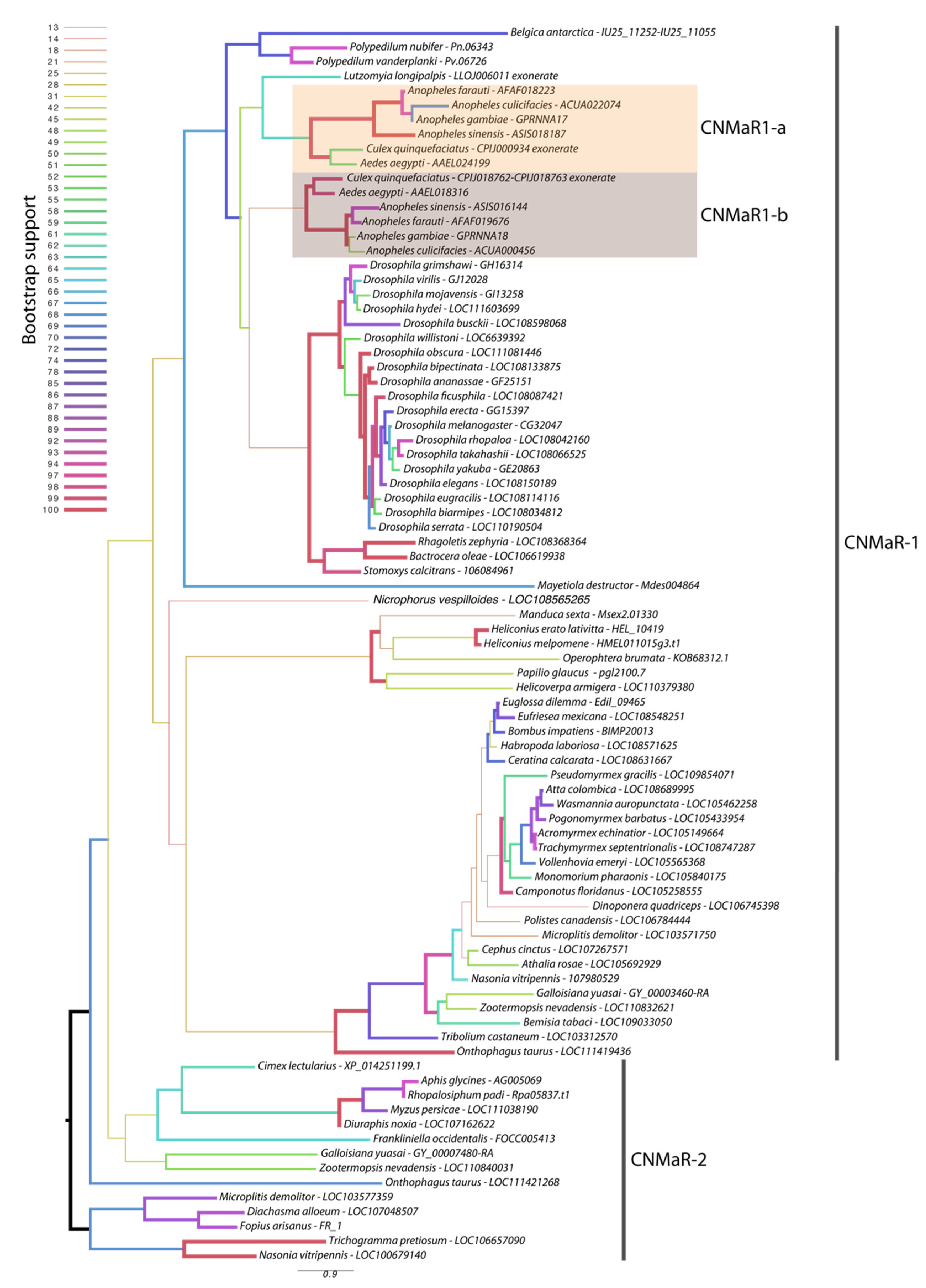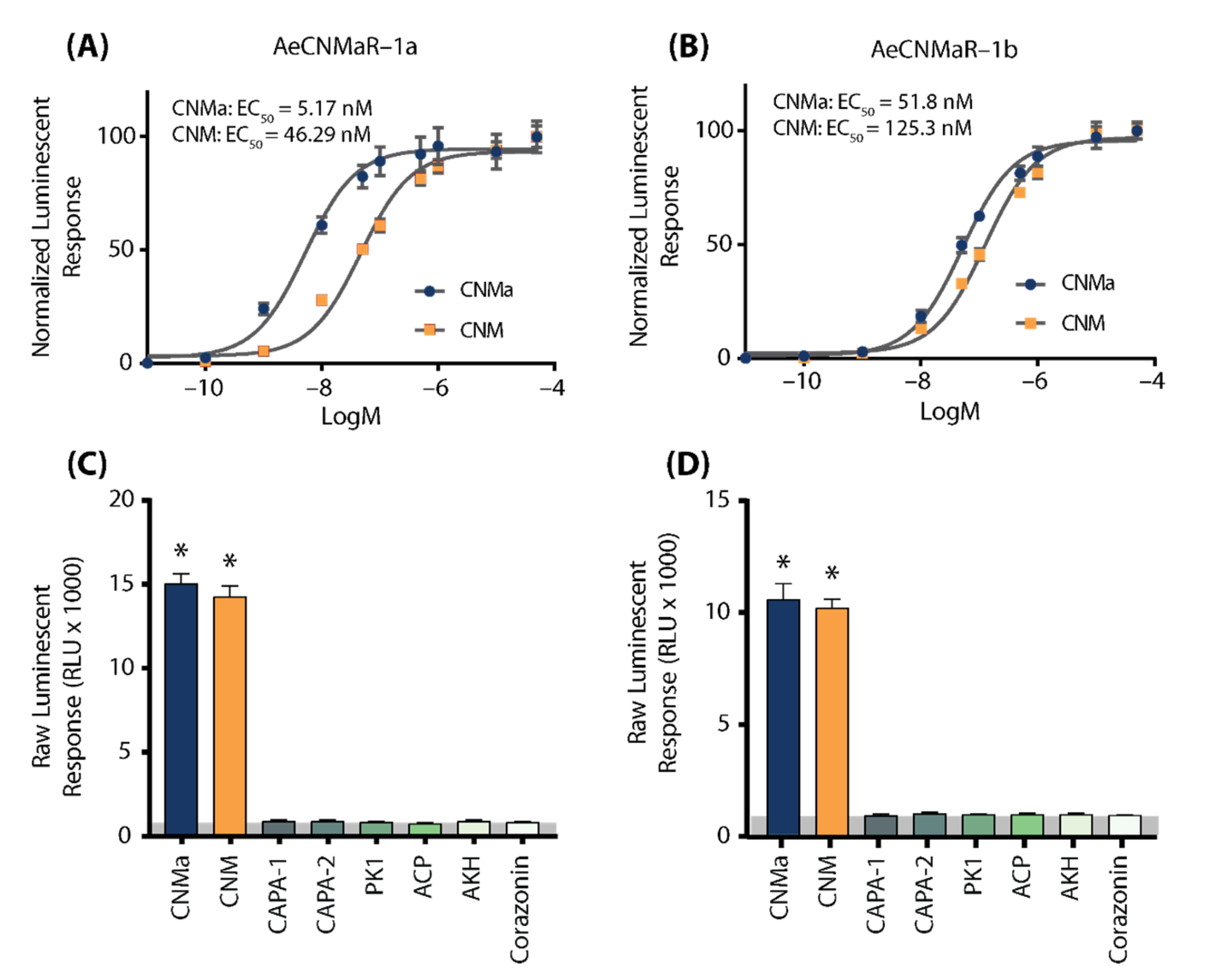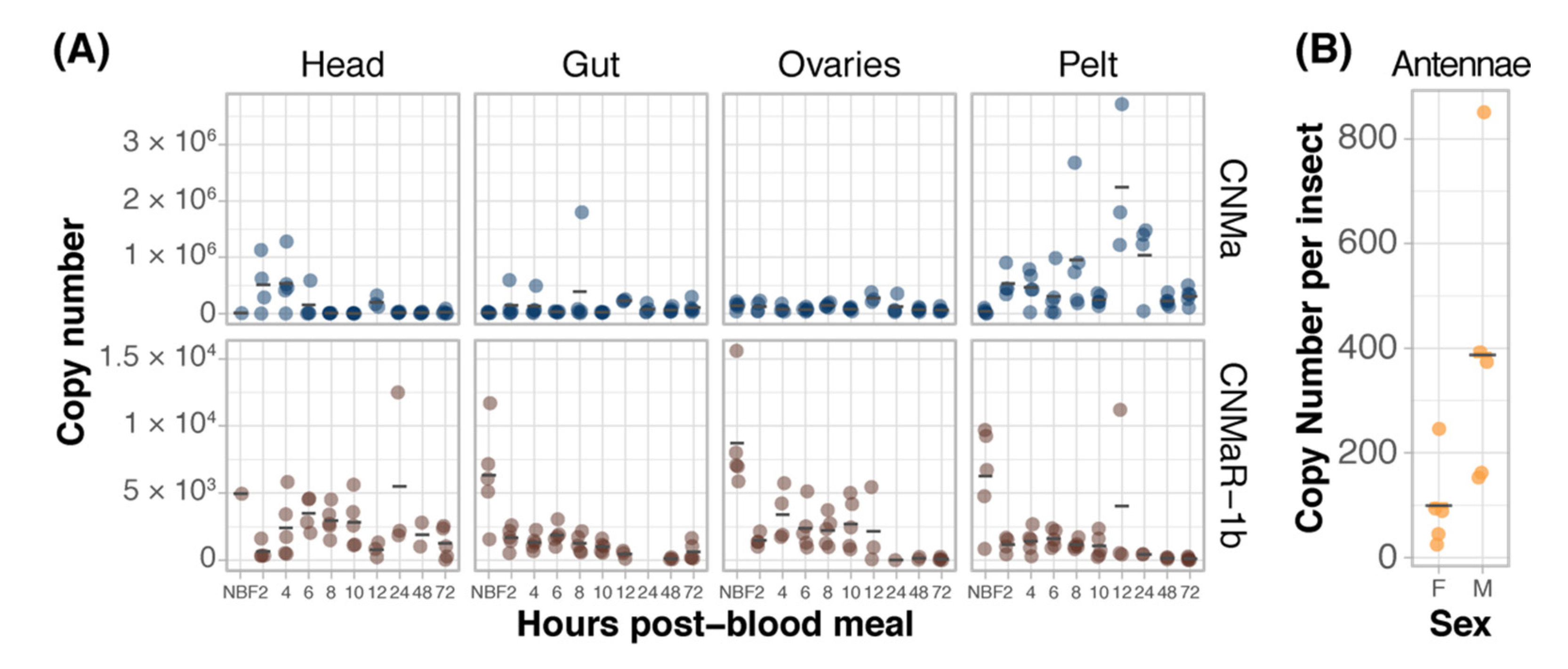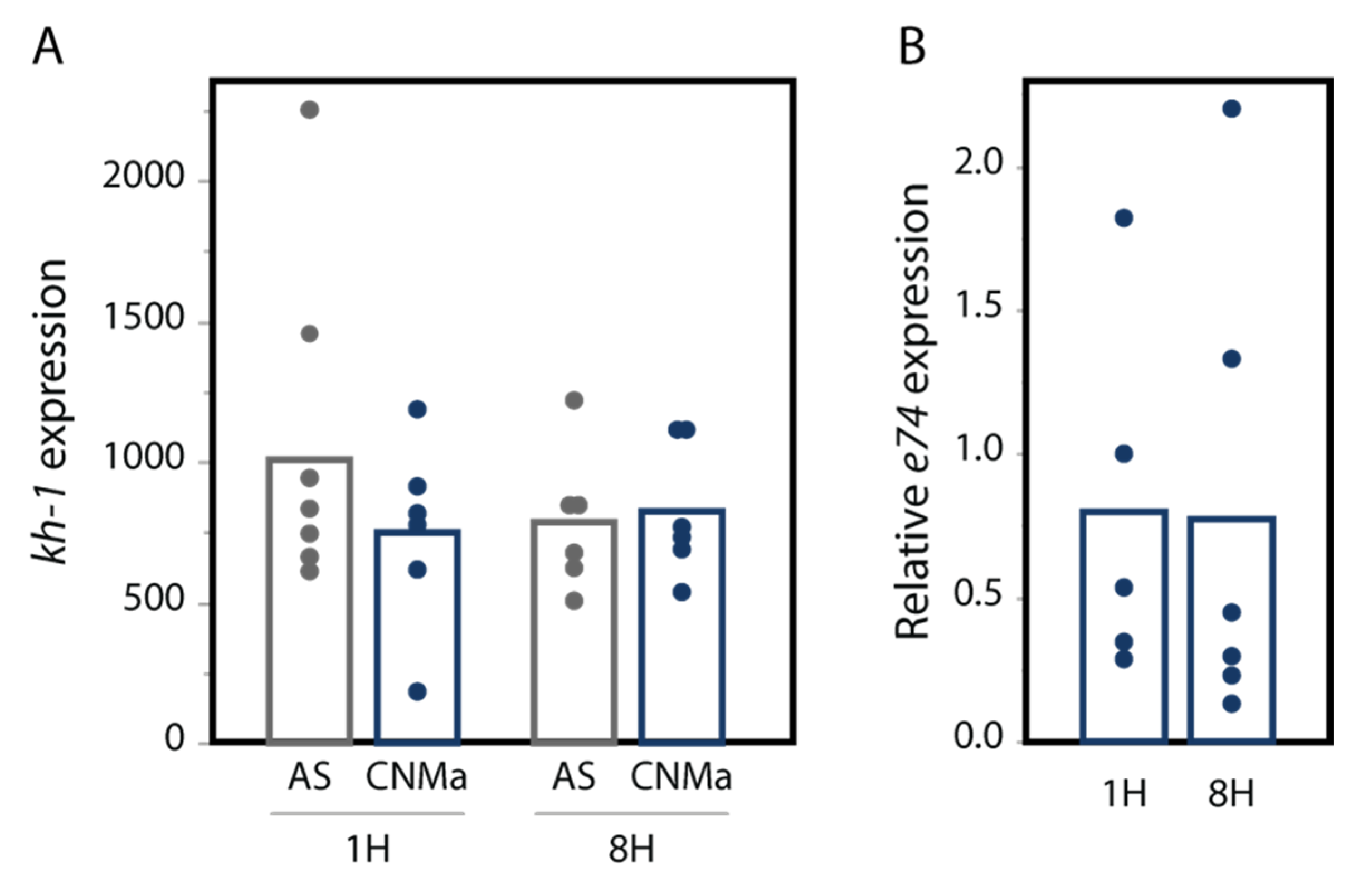The Peptide Hormone CNMa Influences Egg Production in the Mosquito Aedes aegypti
Abstract
:Simple Summary
Abstract
1. Introduction
2. Materials and Methods
2.1. Mosquitoes
2.2. Sequence Analyses
2.3. Peptide Synthesis, Receptor Cloning, and GPCR Activation Assays
2.4. QRT-PCR Analysis of Target Gene Expression
2.5. Bioassays
2.6. Proteomic Studies of Female and Male Tissues
3. Results
3.1. CNMaR-1 Is Duplicated in the Culicidae
3.2. CNMa Receptor Binding
3.3. CNMa Peptide and Receptor Expression
3.4. Effects of AeCNMa Injection on Ae. aegypti Reproduction
3.5. Presence of CNMa in Male Accessory Glands
3.6. Interaction of CNMa and Other Reproductive Hormones
4. Discussion
Supplementary Materials
Author Contributions
Funding
Institutional Review Board Statement
Data Availability Statement
Acknowledgments
Conflicts of Interest
References
- Clifton, M.E.; Noriega, F.G. The Fate of Follicles after a Blood Meal Is Dependent on Previtellogenic Nutrition and Juvenile Hormone in Aedes aegypti. J. Insect Physiol. 2012, 58, 1007–1019. [Google Scholar] [CrossRef] [PubMed] [Green Version]
- Duvall, L.B.; Basrur, N.S.; Molina, H.; McMeniman, C.J.; Vosshall, L.B. A Peptide Signaling System That Rapidly Enforces Paternity in the Aedes aegypti Mosquito. Curr. Biol. 2017, 27, 3734–3742.e5. [Google Scholar] [CrossRef] [Green Version]
- Hiss, E.A.; Fuchs, M.S. The Effect of Matrone on Oviposition in the Mosquito. Aedes aegypti. J. Insect Physiol. 1972, 18, 2217–2227. [Google Scholar] [CrossRef]
- Matsumoto, S.; Brown, M.R.; Suzuki, A.; Lea, A.O. Isolation and Characterization of Ovarian Ecdysteroidogenic Hormones from the Mosquito, Aedes aegypti. Insect Biochem. 1989, 19, 651–656. [Google Scholar] [CrossRef]
- Naccarati, C.; Audsley, N.; Keen, J.N.; Kim, J.-H.; Howell, G.J.; Kim, Y.-J.; Isaac, R.E. The Host-Seeking Inhibitory Peptide, Aea-HP-1, Is Made in the Male Accessory Gland and Transferred to the Female during Copulation. Peptides 2012, 34, 150–157. [Google Scholar] [CrossRef] [PubMed] [Green Version]
- Gulia-Nuss, M.; Robertson, A.E.; Brown, M.R.; Strand, M.R. Insulin-like Peptides and the Target of Rapamycin Pathway Coordinately Regulate Blood Digestion and Egg Maturation in the Mosquito Aedes aegypti. PLoS ONE 2011, 6, e20401. [Google Scholar] [CrossRef]
- Wang, J.-L.; Saha, T.T.; Zhang, Y.; Zhang, C.; Raikhel, A.S. Juvenile Hormone and Its Receptor Methoprene-Tolerant Promote Ribosomal Biogenesis and Vitellogenesis in the Aedes aegypti Mosquito. J. Biol. Chem. 2017, 292, 10306–10315. [Google Scholar] [CrossRef] [Green Version]
- Riehle, M.A.; Brown, M.R. Insulin Stimulates Ecdysteroid Production through a Conserved Signaling Cascade in the Mosquito Aedes aegypti. Insect Biochem. Mol. Biol. 1999, 29, 855–860. [Google Scholar] [CrossRef]
- Brown, M.R.; Clark, K.D.; Gulia, M.; Zhao, Z.; Garczynski, S.F.; Crim, J.W.; Suderman, R.J.; Strand, M.R. An Insulin-like Peptide Regulates Egg Maturation and Metabolism in the Mosquito Aedes aegypti. Proc. Natl. Acad. Sci. USA 2008, 105, 5716–5721. [Google Scholar] [CrossRef] [Green Version]
- Vogel, K.J.; Brown, M.R.; Strand, M.R. Ovary Ecdysteroidogenic Hormone Requires a Receptor Tyrosine Kinase to Activate Egg Formation in the Mosquito Aedes aegypti. Proc. Natl. Acad. Sci. USA 2015, 112, 5057–5062. [Google Scholar] [CrossRef] [Green Version]
- Rivera-Perez, C.; Nouzova, M.; Lamboglia, I.; Noriega, F.G. Metabolic Analysis Reveals Changes in the Mevalonate and Juvenile Hormone Synthesis Pathways Linked to the Mosquito Reproductive Physiology. Insect Biochem. Mol. Biol. 2014, 51, 1–9. [Google Scholar] [CrossRef] [PubMed] [Green Version]
- Gwadz, R.W.; Spielman, A. Corpus Allatum Control of Ovarian Development in Aedes aegypti. J. Insect Physiol. 1973, 19, 1441–1448. [Google Scholar] [CrossRef]
- Vogel, K.J.; Brown, M.R.; Strand, M.R. Phylogenetic Investigation of Peptide Hormone and Growth Factor Receptors in Five Dipteran Genomes. Front. Endocrinol. 2013, 4, 193. [Google Scholar] [CrossRef] [PubMed] [Green Version]
- Predel, R.; Neupert, S.; Garczynski, S.F.; Crim, J.W.; Brown, M.R.; Russell, W.K.; Kahnt, J.; Russell, D.H.; Nachman, R.J. Neuropeptidomics of the Mosquito Aedes aegypti. J. Proteome Res. 2010, 9, 2006–2015. [Google Scholar] [CrossRef] [PubMed] [Green Version]
- Jung, S.-H.; Lee, J.-H.; Chae, H.-S.; Seong, J.Y.; Park, Y.; Park, Z.-Y.; Kim, Y.-J. Identification of a Novel Insect Neuropeptide, CNMa and Its Receptor. FEBS Lett. 2014, 588, 2037–2041. [Google Scholar] [CrossRef] [Green Version]
- Kim, B.; Kanai, M.I.; Oh, Y.; Kyung, M.; Kim, E.-K.; Jang, I.-H.; Lee, J.-H.; Kim, S.-G.; Suh, G.S.B.; Lee, W.-J. Response of the Microbiome–gut–brain Axis in Drosophila to Amino Acid Deficit. Nature 2021, 593, 570–574. [Google Scholar] [CrossRef]
- Akbari, O.S.; Antoshechkin, I.; Amrhein, H.; Williams, B.; Diloreto, R.; Sandler, J.; Hay, B.A. The Developmental Transcriptome of the Mosquito Aedes aegypti, an Invasive Species and Major Arbovirus Vector. G3 Genes Genomes Genet. 2013, 3, 1493–1509. [Google Scholar] [CrossRef] [Green Version]
- Kriventseva, E.V.; Kuznetsov, D.; Tegenfeldt, F.; Manni, M.; Dias, R.; Simão, F.A.; Zdobnov, E.M. OrthoDB v10: Sampling the Diversity of Animal, Plant, Fungal, Protist, Bacterial and Viral Genomes for Evolutionary and Functional Annotations of Orthologs. Nucleic Acids Res. 2019, 47, D807–D811. [Google Scholar] [CrossRef] [Green Version]
- Munoz, S.; Guerrero, F.D.; Kellogg, A.; Heekin, A.M.; Leung, M.-Y. Bioinformatic Prediction of G Protein-Coupled Receptor Encoding Sequences from the Transcriptome of the Foreleg, Including the Haller’s Organ, of the Cattle Tick, Rhipicephalus australis. PLoS ONE 2017, 12, e0172326. [Google Scholar] [CrossRef] [Green Version]
- Slater, G.S.C.; Birney, E. Automated Generation of Heuristics for Biological Sequence Comparison. BMC Bioinform. 2005, 6, 31. [Google Scholar] [CrossRef] [Green Version]
- Katoh, K.; Misawa, K.; Kuma, K.-I.; Miyata, T. MAFFT: A Novel Method for Rapid Multiple Sequence Alignment Based on Fast Fourier Transform. Nucleic Acids Res. 2002, 30, 3059–3066. [Google Scholar] [CrossRef] [PubMed] [Green Version]
- Capella-Gutiérrez, S.; Silla-Martínez, J.M.; Gabaldón, T. trimAl: A Tool for Automated Alignment Trimming in Large-Scale Phylogenetic Analyses. Bioinformatics 2009, 25, 1972–1973. [Google Scholar] [CrossRef] [PubMed]
- Stamatakis, A. RAxML Version 8: A Tool for Phylogenetic Analysis and Post-Analysis of Large Phylogenies. Bioinformatics 2014, 30, 1312–1313. [Google Scholar] [CrossRef]
- Oryan, A.; Wahedi, A.; Paluzzi, J.-P.V. Functional Characterization and Quantitative Expression Analysis of Two GnRH-Related Peptide Receptors in the Mosquito, Aedes aegypti. Biochem. Biophys. Res. Commun. 2018, 497, 550–557. [Google Scholar] [CrossRef]
- Paluzzi, J.-P.; O’Donnell, M.J. Identification, Spatial Expression Analysis and Functional Characterization of a Pyrokinin-1 Receptor in the Chagas’ Disease Vector, Rhodnius prolixus. Mol. Cell. Endocrinol. 2012, 363, 36–45. [Google Scholar] [CrossRef] [PubMed]
- Wahedi, A.; Paluzzi, J.-P. Molecular Identification, Transcript Expression, and Functional Deorphanization of the Adipokinetic Hormone/corazonin-Related Peptide Receptor in the Disease Vector, Aedes aegypti. Sci. Rep. 2018, 8, 2146. [Google Scholar] [CrossRef] [Green Version]
- Sajadi, F.; Uyuklu, A.; Paputsis, C.; Lajevardi, A.; Wahedi, A.; Ber, L.T.; Matei, A.; Paluzzi, J.-P.V. CAPA Neuropeptides and Their Receptor Form an Anti-Diuretic Hormone Signaling System in the Human Disease Vector, Aedes aegypti. Sci. Rep. 2020, 10, 1755. [Google Scholar] [CrossRef]
- Vogel, K.J.; Valzania, L.; Coon, K.L.; Brown, M.R.; Strand, M.R. Transcriptome Sequencing Reveals Large-Scale Changes in Axenic Aedes aegypti Larvae. PLoS Negl. Trop. Dis. 2017, 11, e0005273. [Google Scholar] [CrossRef] [Green Version]
- Valzania, L.; Mattee, M.T.; Strand, M.R.; Brown, M.R. Blood Feeding Activates the Vitellogenic Stage of Oogenesis in the Mosquito Aedes aegypti through Inhibition of Glycogen Synthase Kinase 3 by the Insulin and TOR Pathways. Dev. Biol. 2019, 454, 85–95. [Google Scholar] [CrossRef]
- Neafsey, D.E.; Waterhouse, R.M.; Abai, M.R.; Aganezov, S.S.; Alekseyev, M.A.; Allen, J.E.; Amon, J.; Arcà, B.; Arensburger, P.; Artemov, G.; et al. Mosquito Genomics. Highly Evolvable Malaria Vectors: The Genomes of 16 Anopheles Mosquitoes. Science 2015, 347, 1258522. [Google Scholar]
- McBride, C.S.; Baier, F.; Omondi, A.B.; Spitzer, S.A.; Lutomiah, J.; Sang, R.; Ignell, R.; Vosshall, L.B. Evolution of Mosquito Preference for Humans Linked to an Odorant Receptor. Nature 2014, 515, 222–227. [Google Scholar] [CrossRef] [PubMed]
- Tallon, A.K.; Hill, S.R.; Ignell, R. Sex and Age Modulate Antennal Chemosensory-Related Genes Linked to the Onset of Host Seeking in the Yellow-Fever Mosquito, Aedes aegypti. Sci. Rep. 2019, 9, 43. [Google Scholar] [CrossRef] [PubMed] [Green Version]
- Wu, Q.; Brown, M.R. Signaling and Function of Insulin-like Peptides in Insects. Annu. Rev. Entomol. 2006, 51, 1–24. [Google Scholar] [CrossRef]
- Dhara, A.; Eum, J.-H.; Robertson, A.; Gulia-Nuss, M.; Vogel, K.J.; Clark, K.D.; Graf, R.; Brown, M.R.; Strand, M.R. Ovary Ecdysteroidogenic Hormone Functions Independently of the Insulin Receptor in the Yellow Fever Mosquito, Aedes aegypti. Insect Biochem. Mol. Biol. 2013, 43, 1100–1108. [Google Scholar] [CrossRef] [Green Version]
- Palatini, U.; Masri, R.A.; Cosme, L.V.; Koren, S.; Thibaud-Nissen, F.; Biedler, J.K.; Krsticevic, F.; Johnston, J.S.; Halbach, R.; Crawford, J.E.; et al. Improved Reference Genome of the Arboviral Vector Aedes albopictus. Genome Biol. 2020, 21, 215. [Google Scholar] [CrossRef] [PubMed]
- Roy, S.G.; Hansen, I.A.; Raikhel, A.S. Effect of Insulin and 20-Hydroxyecdysone in the Fat Body of the Yellow Fever Mosquito, Aedes aegypti. Insect Biochem. Mol. Biol. 2007, 37, 1317–1326. [Google Scholar] [CrossRef] [PubMed] [Green Version]
- Sieglaff, D.H.; Duncan, K.A.; Brown, M.R. Expression of Genes Encoding Proteins Involved in Ecdysteroidogenesis in the Female Mosquito, Aedes aegypti. Insect Biochem. Mol. Biol. 2005, 35, 471–490. [Google Scholar] [CrossRef]
- Roy, S.G.; Raikhel, A.S. Nutritional and Hormonal Regulation of the TOR Effector 4E-Binding Protein (4E-BP) in the Mosquito Aedes aegypti. FASEB J. 2012, 26, 1334–1342. [Google Scholar] [CrossRef] [Green Version]







Publisher’s Note: MDPI stays neutral with regard to jurisdictional claims in published maps and institutional affiliations. |
© 2022 by the authors. Licensee MDPI, Basel, Switzerland. This article is an open access article distributed under the terms and conditions of the Creative Commons Attribution (CC BY) license (https://creativecommons.org/licenses/by/4.0/).
Share and Cite
Keyes-Scott, N.I.; Lajevardi, A.; Swade, K.R.; Brown, M.R.; Paluzzi, J.-P.; Vogel, K.J. The Peptide Hormone CNMa Influences Egg Production in the Mosquito Aedes aegypti. Insects 2022, 13, 230. https://doi.org/10.3390/insects13030230
Keyes-Scott NI, Lajevardi A, Swade KR, Brown MR, Paluzzi J-P, Vogel KJ. The Peptide Hormone CNMa Influences Egg Production in the Mosquito Aedes aegypti. Insects. 2022; 13(3):230. https://doi.org/10.3390/insects13030230
Chicago/Turabian StyleKeyes-Scott, Nia I., Aryan Lajevardi, Kyle R. Swade, Mark R. Brown, Jean-Paul Paluzzi, and Kevin J. Vogel. 2022. "The Peptide Hormone CNMa Influences Egg Production in the Mosquito Aedes aegypti" Insects 13, no. 3: 230. https://doi.org/10.3390/insects13030230
APA StyleKeyes-Scott, N. I., Lajevardi, A., Swade, K. R., Brown, M. R., Paluzzi, J.-P., & Vogel, K. J. (2022). The Peptide Hormone CNMa Influences Egg Production in the Mosquito Aedes aegypti. Insects, 13(3), 230. https://doi.org/10.3390/insects13030230





